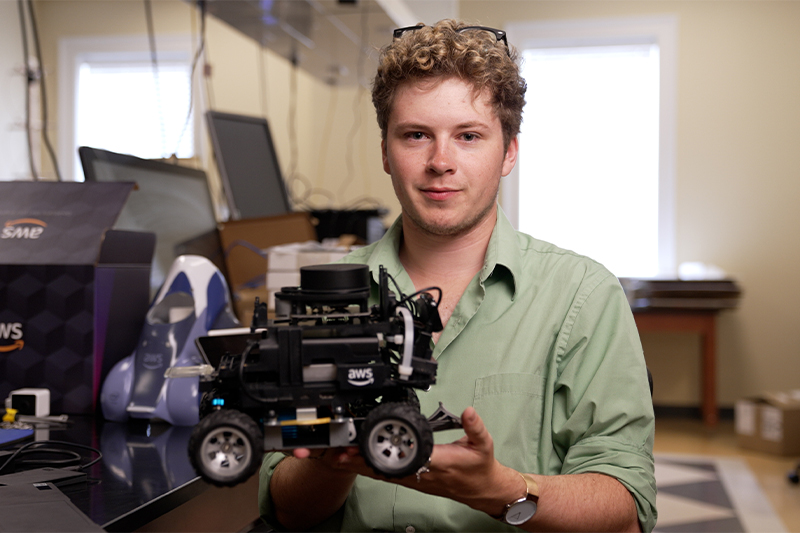
Read time:
Christopher Williams spent the summer with a robot that inspired, frustrated and challenged him.
It was a complicated relationship that tested his patience and knowledge. Williams was a Summer Scholar who focused his research on building a robot named MARTY (Mobile Autonomous Robot Tracking Youth) that he anticipates one day will be able to be a reliable delivery source at Christopher Newport, bringing items to students across campus.
Working with MARTY was a journey of highs and lows. But Williams, ‘25 Computer Science, in an effort to bring MARTY to life, persevered and, in the process, learned a lot about himself and his capabilities.
“I kept telling myself that ‘I can do it.’ The whole is much greater than the problems,” he said.
As a Summer Scholar, Williams worked with Dr. Mohammad Almalag, on a quest to design MARTY in a way that would produce results. The big-picture goal is to have MARTY observe pedestrians and learn from their actions as they move from place to place and incorporate those lessons into the way it navigates.
Summer Scholars is an eight-week, in-residence program unique to Christopher Newport that encourages students to collaborate with faculty to answer research questions. Scholars receive a housing allowance and stipend. Applications are open through Friday, February 9, for the next group of Summer Scholars.
Positioned next to Williams’ computer in a lab in Luter Hall, MARTY, made of black metal, looked up with its one eye as if to say to his creator, “I’m ready. Put me to work.”
Not human, but definitely a creature that pushed Williams to be the best version of himself when it came to research and grit.
The evolution of MARTY generated a wave of challenges that Williams was tasked to remedy. There was the problem where MARTY confused backward and forward. Or when MARTY’s eye needed to be replaced with one that was more effective. At one point, MARTY was deemed a threat to the WiFi system.
Quickly, Williams developed a love/hate with the robot, one that tested his know-how and patience at every turn of development. Despite the roadblocks, trying to breathe life into a robot has been “a great experience,” Williams said.
“It opens your eyes for what’s out there and what can be done,” he said. “It’s been very interesting.”
All of the hurdles have required Williams to dig deep into research and find ways to correct MARTY’s shortfalls. For Williams, the quest for knowledge and answers has been fascinating and enlightening, as he is a passionate learner who thrives on finding ways to problem solve.
“I’m a nerd at heart,” said Williams, who also plays baritone in the marching band. “I love things that just have extensive knowledge, things I can dig into. As hard as this was, it was fun.”
Williams put his creativity and outside-the-box thinking on full throttle to get MARTY to achieve the end goal of reading people’s movements.
What Williams found was that making MARTY operate accordingly translates into loading him up with different programming and utilizing significant ingenuity. Williams is not about to give up, he’s in for the long haul, and on a mission to one day see MARTY chugging around campus.
That may take time, and lots more research, he said. The deeper he digs, the broader his base of knowledge becomes and the more adept he gets at programming, and mastering the ins and outs of robot mechanisms.
“It takes a lot of perseverance,” he said. “I’m impressed at how well I could stick with it.”
Building MARTY’s so-called brain has meant a lot of trial and error.
“It has been like a Mount Everest sized wall in front of me,” he said. “I had to learn to climb the wall myself. I have gotten myself up. I now know that I can do it. It’s been grueling, but I got there.”
“I love problem solving,” he said. “It’s so satisfying when it works.”
Williams plans to continue working on advancing MARTY’s skills as the year progresses. He is hopeful he can tap into more people’s expertise, collaboration and opinions about the best way to expand MARTY’s capabilities. In the end, he wants to share with the world, in a published paper, how he successfully made MARTY function. “We want to be able to say that he did it, that we tried and it works,” he said.
Williams is optimistic that experience with MARTY will help him as he chugs toward graduation and entering the workforce. His goal is to one day work in a city being built in Japan by Toyota for its employees. The city, called the Woven City, will be a pedestrian city that is self-contained and dependent in large part on robotics.
“Living and working in the Woven City has captivated me,” he said. “I hope this will lead to going there.”
Williams, who is from Northern Virginia, had never engaged in robotics before college, but has a natural knack for computers. The opportunity to research as an undergraduate, he said, has been a huge boon to his education, and one of the reasons Christopher Newport was appealing to him.
“I applied and was accepted to a number of highly competitive schools,” he said. “But they had a teach-yourself approach. I chose CNU because of the small class sizes, the research opportunities and the fact that you can get to know your professors.”